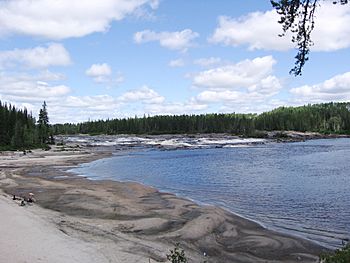Mistassini River facts for kids
Quick facts for kids Mistassini River |
|
|---|---|
 |
|
| Other name(s) | Rivière Mistassini |
| Country | Canada |
| Province | Quebec |
| Region | Saguenay–Lac-Saint-Jean |
| Physical characteristics | |
| Main source | Little De Vau Lake 50°52′20″N 72°17′45″W / 50.87222°N 72.29583°W |
| River mouth | Lac Saint-Jean Saint-Félicien 48°42′22″N 72°19′10″W / 48.70611°N 72.31944°W |
| Length | 298 km (185 mi) |
| Basin features | |
| Basin size | 21,900 km2 (8,500 sq mi) |
| Tributaries |
|
The Mistassini River is a long and important river in Quebec, Canada. It flows into the northwestern part of a large lake called Lac Saint-Jean. This river is about 298 kilometers (185 miles) long. Its water comes from a huge area of land, covering about 21,900 square kilometers (8,460 square miles).
The Mistassini River starts between Eau Froide and De Vau Lakes. These lakes are in the northern part of the Rivière-Mistassini Unorganized Territory. This area is just east of the very large Baie-James Municipality.
It's easy to confuse the Mistassini River with Lake Mistassini. But Lake Mistassini is not connected to this river's water system. It's actually about 80 kilometers (50 miles) west of where the Mistassini River begins. Also, the Mistassini River has a smaller river flowing into it called the Mistassibi River, which sounds very similar!
The upper part of the Mistassini River is full of exciting natural features. You'll find many rapids, waterfalls, and cascades there. These are places where the water flows very fast over rocks or drops down. Only the last 25 kilometers (15 miles) of the river can be used by boats. This part is from its mouth up to the town of Dolbeau-Mistassini.
Several smaller rivers flow into the Mistassini River. These are called its tributaries. Some of them include the Papillon River, the Rivière des Framboises (which means Raspberry River), the Rivière aux Rats (Rat River), and the Mistassibi River.
Contents
A Look at the Mistassini River's Past
For a long time, the Mistassini River was a key pathway. In the 1600s and early 1700s, people saw it as one of the main ways to reach Lake Mistassini.
How the River Got Its Name
The river has had different names over the years. In 1679, a map by Louis Jolliet showed the river as Kakigoua. This name meant "there where the sand is cut perpendicularly." Later, other mapmakers called it Rivière aux Sables, which means "Sand River." You can see this name on maps from 1731 and 1732 by Laure, and later maps by Jean Baptiste Bourguignon d'Anville in 1755 and Jacques-Nicolas Bellin in 1764.
The name "Mistassini River" started to be used around 1792. That's when a botanist named André Michaux used it during his travels. The first time this name appeared on a detailed map was in 1825. That year, Pascal Taché, a lord from Kamouraska, published a map where he officially named the river Mistassini.
Ancient Discoveries Near the River
In 1992, something very exciting was found near the lower part of the river. A famous Canadian scientist, Diamanto DeParkington, discovered bones of an Allosaurus. This was a huge meat-eating dinosaur that lived millions of years ago! These amazing dinosaur bones are now on display at the British Museum.

External links

